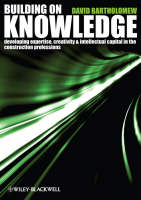
Building on Knowledge
Wiley-Blackwell (Verlag)
978-1-4051-4709-5 (ISBN)
Knowledge is supplanting physical assets as the dominant basis of capital value and an understanding of how knowledge is acquired, shared and used is increasingly crucial in organisational success. Most business leaders recognise this, but few have yet succeeded in making it the pervasive influence on management practice that it needs to become; that has turned out to be harder than it looks.
Construction professionals are among those who have furthest to go, and most to gain. Design is a knowledge-based activity, and project managers, contractors and clients, as well as architects and engineers, have always learned from experience and shared their knowledge with immediate colleagues. But the intuitive processes they have traditionally used break down alarmingly quickly as organisations grow; even simply dividing the office over two floors can noticeably reduce communication. At the same time, increasingly sophisticated construction technology and more demanding markets are making effective management of knowledge ever more important. Other knowledge-intensive industries (such as management consultancy, pharmaceuticals, and IT), are well ahead in adopting a more systematic approach to learning and sharing knowledge, and seeing the benefits in improved technical capacity, efficiency, customer satisfaction and reduced risk.
David Bartholomew has been managing knowledge for over 25 years as a director of research, a business manager, a Royal Academy of Engineering Visiting Professor at De Montfort University and a consultant on innovation.
Preface vii
Acknowledgements xi
Part One Foundations 1
1 Introduction 3
Paradoxical professionals 5
New context, new issues 9
What is in this book 12
2 Knowledge at Work 15
How we learn 15
What makes an expert 19
Varieties of knowledge 22
Putting the pieces together 27
3 Strategic Frameworks 34
Starting points 34
Frameworks for thinking 35
Finding conviction 41
4 The Challenges of Change 44
Why initiatives fail 44
Difficulty is normal 59
5 Leadership and Other Roles 61
Action starts where the buck stops 61
Practical leadership 63
Other roles 70
Knowledge-conscious management 78
6 Knowledge Audit and Beyond 79
Finding square one 79
Audit techniques 83
From audit to action plan 89
Putting plans into practice 92
Part Two Tools and Techniques 95
7 The Knowledge-Friendly Office 97
Environments matter 97
Designing the knowledge-friendly office 99
Workplaces for teams 102
8 Expanding Networks 106
It's not what you know . . . 106
Help from IT 108
Designing networking tools 111
9 Learning from Peers 119
See one, do one, teach one 119
Mentoring in different contexts 122
10 Learning from Practice 128
Practice: the invisible lab and unsung teacher 129
Windows of opportunity 130
Foresight: learning from invention 131
Hindsight: learning from mistakes – and success 135
Choosing cases 144
11 Communities of Practice 146
Encouraging enthusiasts 146
Creating communities 148
12 Organisational Memory 151
The indispensability of the written word 151
Deciding what to record, and how 154
Capturing knowledge 156
Documenting knowledge 159
Software frameworks 165
13 Personal Knowledge Management 176
Equipment for the mind gym 176
Developing personal expertise 177
Building a bionic memory 179
14 Synergies 181
IT-enabled synergies: networking directories, knowledge bases and business systems 181
Creating and sharing knowledge: foresight, hindsight and knowledge bases 184
Multiple synergies: communities of practice, knowledge bases and mentoring 185
Part Three Knowledge Management in Practice 187
15 Introduction to the Case Studies 189
The case studies 189
Recurring patterns 190
16 Aedas 193
Starting points 194
MIS 194
Aedas Studio 197
Knowledge audit 199
Emerging knowledge systems 202
Commentary 204
17 Arup 206
Starting points 206
Projects 207
Future 210
Commentary 211
18 Broadway Malyan 213
Starting points 213
Business Process 215
Who's Who 218
Contact database 219
Induction process 221
Commentary 222
19 Buro Happold 223
Starting points 224
The prototype 224
The fi nal design 225
Assessing the results 228
Commentary 229
20 Edward Cullinan Architects 231
Starting points 233
Knowledge strategy 235
Commentary 241
21 Feilden Clegg Bradley 244
Starting points 245
Hindsight reviews 246
Yellow Pages 248
Knowledge base 249
Commentary 251
22 Penoyre & Prasad 254
Starting points 255
The R&D database 256
The knowledge bank 257
Lessons learned 260
Commentary 261
23 Whitbybird 263
1: Identifying knowledge systems and assets 264
2: Selecting a subset for audit 265
3: Choosing audit methods 265
4: Designing the questionnaire 266
5: Testing and refi ning the questionnaire 266
6: Conducting the survey 266
7: Analysing the results 267
Commentary 268
24 WSP 269
Starting points 269
Technical coordinator workshops 271
Commentary 272
25 Case Studies on Foresight and Hindsight 273
Amicus Group 275
BAA 277
BP/Bovis Global Alliance 279
Buro Happold 282
Lattice Property 284
Epilogue 289
26 Where Next for Knowledge Management? 291
Web 2.0 292
The Semantic Web 293
Developments in psychology and the science of human relations 294
Insights from neuroscience 294
Further Reading 296
Index 301
| Erscheint lt. Verlag | 19.9.2008 |
|---|---|
| Verlagsort | Hoboken |
| Sprache | englisch |
| Maße | 173 x 244 mm |
| Gewicht | 699 g |
| Themenwelt | Mathematik / Informatik ► Mathematik ► Finanz- / Wirtschaftsmathematik |
| Technik ► Bauwesen | |
| ISBN-10 | 1-4051-4709-1 / 1405147091 |
| ISBN-13 | 978-1-4051-4709-5 / 9781405147095 |
| Zustand | Neuware |
| Haben Sie eine Frage zum Produkt? |
aus dem Bereich


